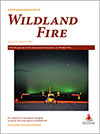
International Journal of Wildland Fire
Volume 31 Number 9 2022
Ontario’s Modifying Industrial Operations Protocol aims to limit wildland fire risks associated with forestry operations. We empirically investigated how the distribution of incremental growth between discovery and final sizes of industrial forestry-caused fires have changed over time, finding evidence suggesting that fires tend to grow less under current regulations.
WF22074 Abstract | WF22074 Full Text | WF22074PDF (2.5 MB) Open Access Article
WF22015A case-study ofwildland fire management knowledge exchange: the barriers and facilitators in the development and integration of the Canadian Forest Fire Danger Rating System in Ontario, Canada
We describe the barriers and facilitators for knowledge exchange for wildland fire management elicited from a case study of the Canadian Forest Fire Danger Rating System development and implementation in Ontario. These findings can help guide the development and implementation of future innovations for wildland fire management.
WF22015 Abstract | WF22015 Full Text | WF22015PDF (1.8 MB) | WF22015Supplementary Material (372 KB) Open Access Article
WF22017Sand and fire: applying the sandpile model of self-organised criticality to wildfire mitigation†
The sandpile model uses accumulating sand grains to approximate net fuel deposition. When a collapse occurs, it spreads, simulating the spread of fire. Data from both a sandpile model simulation and an analysis of historical forest fire data suggest that prescribed burning reduces the risk of destructive wildfires.
WF22017 Abstract | WF22017 Full Text | WF22017PDF (3.5 MB) | WF22017Supplementary Material (1.7 MB) Open Access Article
We tested the flammable properties of Pinus banksiana living needles in a laboratory. Needles ignite faster the older they are, influenced mainly by their form. Their chemical makeup affects the speed, energy released during combustion and consumption velocity. Our study showed that, surprisingly, moisture content was not the main factor controlling their flammability.
WF22008 Abstract | WF22008 Full Text | WF22008PDF (4.2 MB) | WF22008Supplementary Material (371 KB) Open Access Article
WF21133Estimating visitor preferences for recreation sites in wildfire prone areas
This study investigates visitor preferences for tree cover, waterbodies and visual evidence of past fire at recreation sites in a Southern California national forest. Findings show that water and tree cover are highly valued, and fire impacts depend on vegetation type, fire intensity and time since the fire.
WF21133 Abstract | WF21133 Full Text | WF21133PDF (4.6 MB) Open Access Article
WF22033The process of vegetation recovery and burn probability changes in post-burn boreal forests in northeast China
The recovery process and corresponding fire likelihood of post-burn boreal forests were identified. Soil depth and slope played important roles in vegetation recovery. Most burned areas recovered and showed low burn probability 20 years post burn.
We studied the wildfire response of GPS-tracked Bonelli’s eagles. We used kernel density estimators and movement parameters comparing individuals’ behaviour before, during and after a wildfire. We only saw an immediate negative effect in the first days of the wildfire. This could be an adaptation to wildfires in Mediterranean areas.




